#NOIRLAB
Text
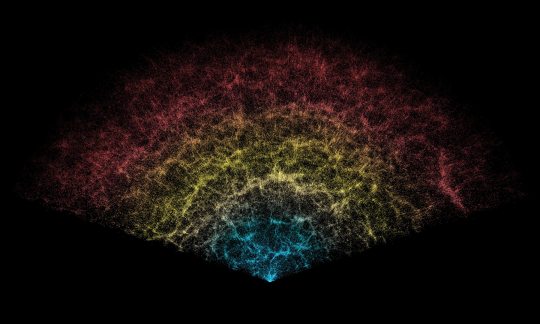
DESI Map !
A slice of the 3D map of galaxies collected in the first year of the Dark Energy Spectroscopic Instrument (DESI) Survey. Earth is at the tip, with the furthest galaxies plotted at distances of 11 billion light-years. Each point represents one galaxy.
This version of the DESI map includes 600,000 galaxies — less than 0.1% of the survey's full volume.
Credit: DESI Collaboration/NOIRLab/NSF/AURA/R. Proctor
#art#cosmos#cosmic#universe#blast#space#wallpaper#desi map#3D map#galaxies#galaxy#dark energy spectroscopic instrument#survey#NOIRlab
22 notes
·
View notes
Photo
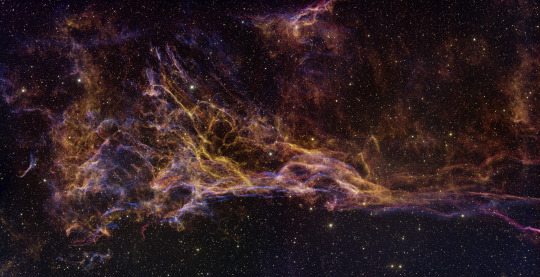
Pickering's Triangle image taken with the Mayall 4-meter Telescope
A wide-field image of Pickering's Triangle taken with the U.S. National Science Foundation's Mayall 4-meter Telescope at Kitt Peak National Observatory. Pickering's Triangle is part of the Cygnus Loop supernova remnant.
Credit: T.A. Rector/University of Alaska Anchorage, H. Schweiker/WIYN and NOIRLab/NSF/AURA (Available under Creative Commons Attribution 4.0 International)
#t a rector#university of alaska anchorage#h schweider#wiyn#noirlab#national science foundation-ocean observatory initiative#aura#pickering's triangle#astronomy#space#mayall 4-meter telescope#cygnus loop supernova#nature
18 notes
·
View notes
Text
The World's Biggest Digital Camera Is Finally Complete
Nine years and 3.2 billion pixels later, it is complete: the LSST Camera stands as the largest digital camera ever built for astronomy and will serve as the centerpiece of the Vera Rubin Observatory, poised to begin its exploration of the southern skies.
Giancarlo Esposito on Having His Own Action Figures
The Rubin Observatory’s key goal is the 10-year Legacy Survey of Space and Time (LSST), a…

View On WordPress
#Aaron Roodman#Astronomical surveys#euclid#galaxy#Gizmodo#Hubble Space Telescope#Internet#LSST#maserati#NOIRLab#Optical telescopes#Rubin Observatory#space telescopes#spacex#Technology#Vera C. Rubin Observatory#Željko Ivezić
0 notes
Text
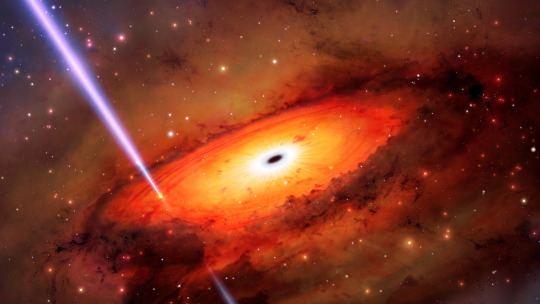
Gamma Ray Burst (Id: noirlab2319a, Release date: 22 June '23),
space art by Mark A. Garlick & Mahdi Zamani.
Article:
1 note
·
View note
Text
Great discovery For the first time astronomers observe a planet devoured by its star
Gran descubrimiento Por primera vez astrónomos observan un planeta cer devorado por su estrella
Un equipo de astrónomos registró la primera evidencia de una estrella moribunda, similar al Sol, devorando un exoplaneta, gracias a observaciones realizadas con el telescopio de Gemini Sur en Chile, que opera NOIRLab de NSF y Observatorio AURA
La evidencia irrefutable de este evento quedó registrada…

View On WordPress
0 notes
Text
Encontraron la ráfaga de rayos gamma más poderosa del universo
Radioastronomía
En las primeras horas de la mañana de hoy, 14 de octubre de 2022, los astrónomos que utilizan el telescopio Gemini Sur en Chile operado por NOIRLab de NSF observaron las consecuencias sin precedentes de una de las explosiones más poderosas jamás registradas, Gamma-Ray Burst GRB221009A. Este evento récord, que fue detectado por primera vez el 9 de octubre de 2022 por telescopios de rayos X y rayos…

View On WordPress
0 notes
Photo
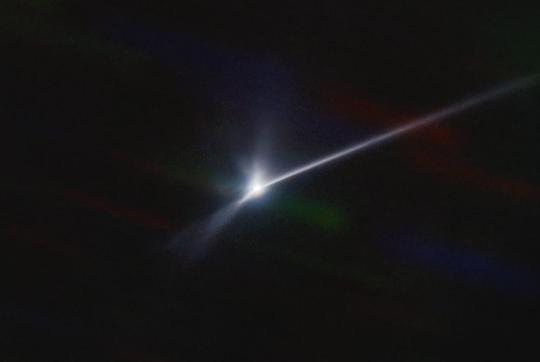
This image made available by NOIRLab shows a plume of dust and debris blasted from the surface of the asteroid Dimorphos by NASA's DART spacecraft after it impacted on Sept. 26, 2022, captured by the U.S. National Science Foundation's NOIRLab's SOAR telescope in Chile. The expanding, comet-like tail is more than 6,000 miles (10,000 kilometers) long. (Teddy Kareta, Matthew Knight/NOIRLab via AP)
#dimorphos#asteroid#space#nasa#dart spacecraft#impactor#soar telescope#noirlab#science#impact#telescope
0 notes
Text
Telescopes Illuminate the Christmas Tree Cluster
#Christmas Tree Cluster#NGC 2264#T.A. Rector#B.A. Wolpa#Frattare & J.Major#NASA/CXC/SAO#NRAO/AUI/NSF#NOIRLab/NSF/AURA#NASA/NSF/IPAC/CalTech/Univ. of Massachusetts#NASA/CXC/SAO/L
0 notes
Text
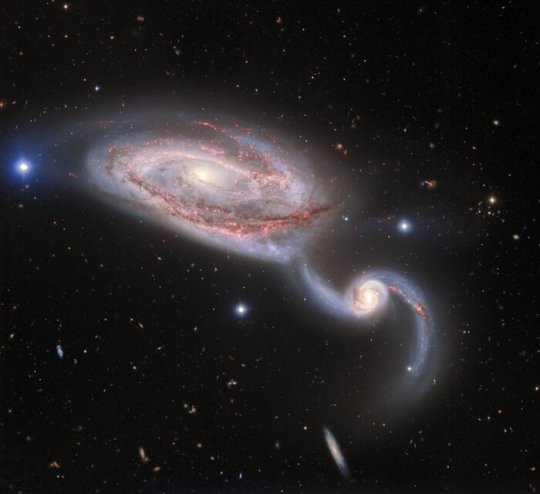
Galactic Dance: NGC 5394/5 © NOIRLab
823 notes
·
View notes
Photo
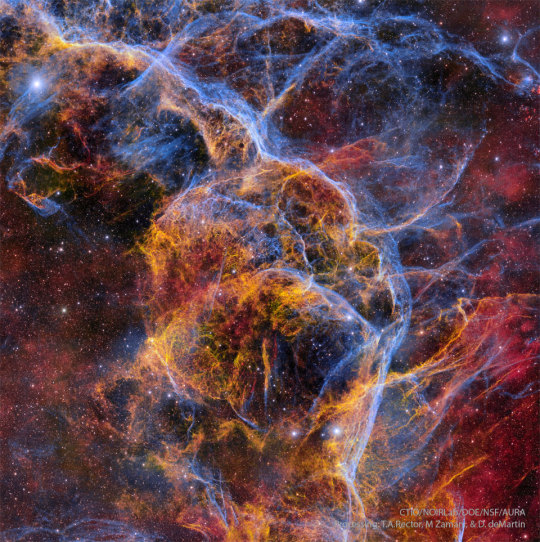
2024 April 16
Filaments of the Vela Supernova Remnant
Image Credit: CTIO, NOIRLab, DOE, NSF, AURA; Processing: T. A. Rector (U. Alaska Anchorage), M. Zamani & D. de Martin (’s NOIRLab)
Explanation: The explosion is over, but the consequences continue. About eleven thousand years ago, a star in the constellation of Vela could be seen to explode, creating a strange point of light briefly visible to humans living near the beginning of recorded history. The outer layers of the star crashed into the interstellar medium, driving a shock wave that is still visible today. The featured image captures some of that filamentary and gigantic shock in visible light. As gas flies away from the detonated star, it decays and reacts with the interstellar medium, producing light in many different colors and energy bands. Remaining at the center of the Vela Supernova Remnant is a pulsar, a star as dense as nuclear matter that spins around more than ten times in a single second.
∞ Source: apod.nasa.gov/apod/ap240416.html
110 notes
·
View notes
Text

The two interacting galaxies making up the pair known as Arp-Madore 608-333 seem to float side by side in this image from the NASA/ESA Hubble Space Telescope.
Credits: ESA/Hubble & NASA, Dark Energy Survey/DOE/FNAL/DECam/CTIO/NOIRLab/NSF/AURA, J. Dalcanton
1K notes
·
View notes
Text
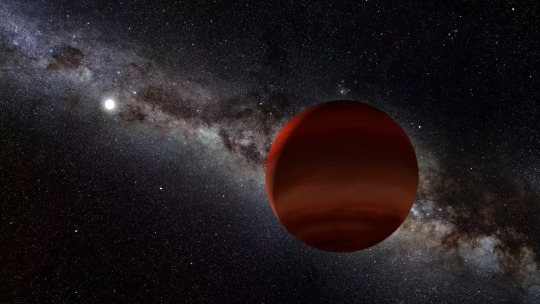
Brown Dwarf !
NOIRLab/NSF/AURA/P. Marenfeld/Acknowledgement: William Pendrill
#art#cosmos#cosmic#universe#blast#space#wallpaper#stars#space wallpaper#NOIRlab#brown#dwarf#william pendrill#AURA#P.Marenfeld
15 notes
·
View notes
Text

IC 4633.
Distance: 100 million light years.
Credit: ESA/Hubble & NASA, J. Dalcanton, Dark Energy Survey/DOE/FNAL/DECam/CTIO/NOIRLab/NSF/AURA.
#space#science#nature#astronomy#Universe#Cosmos#Astrophotography#NASA#astro community#outer space#astrophysics#cosmology#hubble space telescope#galaxy
46 notes
·
View notes
Photo

Green flash at sunset, CTIO/NOIRLab/NSF/AURA/T.Slovinský/P.Horálek
249 notes
·
View notes
Text

A galactic photo shoot has captured more than 3 billion stars and galaxies in one of the biggest sky surveys ever.
Survey was made by The National Science Foundation’s NOIRLab.
This latest survey now covers 6.5% of the night sky, according to the researchers.
With hundreds of billions of stars in the Milky Way, the cosmic catalog is certain to grow.
If you enjoyed this video, please give it a ❤️ and check out @scienceisdope for more science and daily facts.
110 notes
·
View notes
Text
Citizen scientists discover dozens of new cosmic neighbors in NASA data
Científicos ciudadanos descubren docenas de nuevos vecinos cósmicos en datos de la NASA
Usando un programa de software diseñado por la NASA, los miembros del público ayudaron a identificar un alijo de enanas marrones, a veces llamadas estrellas fallidas, que acechan en nuestro vecindario cósmico
Crédito: NOIRLab/NSF/AURA/P. Marenfeld/Reconocimiento: William Pendrill
Nunca hemos conocido a…
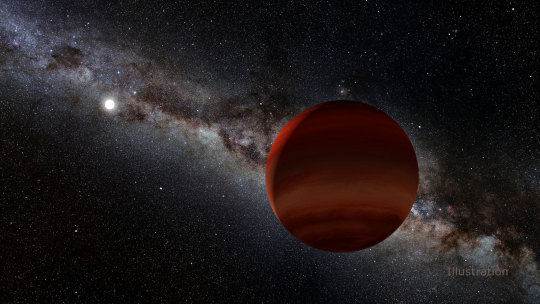
View On WordPress
#Alma#Astrofísica#Centro de Vuelo Espacial Goddard#Ciencias y Tecnologías#Cosmos#Descubrimientos#Enana marrón#Enana roja#Kitt peak#NASA#Noirlab#Spitzer#Tololo#Universo#Wise
0 notes